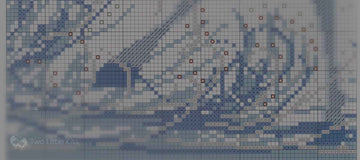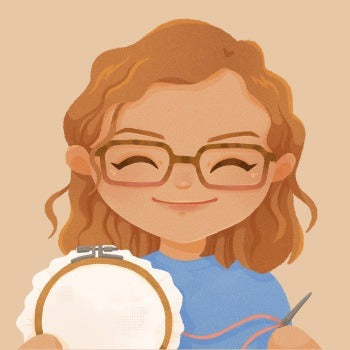When Good Patterns Go Wild: 5 Common Stitching Disasters (and How to Fix 'Em!)
Cross-stitch patterns are meant to be our roadmaps — guides that take us from blank fabric to beautiful finishes. But sometimes those “maps” feel more like riddles. Whether it's near-identical symbols, missing legends, or layouts that make your eyes cross, a tricky pattern can zap the fun right out of stitching.
The good news? With a little creativity (and a lot of stubborn stitcher spirit), most of these issues can be worked around. Below, I'll share five common pattern perils I've seen (or heard about), along with some handy fixes to get you back to enjoying your needle and floss.
If you haven't already, you might also enjoy my earlier post on understanding cross-stitch symbols. It's a great companion to this one, helping you untangle some of the trickier chart issues before they turn into stitching stress.
-
Symbol Similarities That Make You Squint
This is, unfortunately, a really common occurrence — especially with newer designers who don't test stitch their patterns before releasing them. It's such a shame, because a muddle of look-alike symbols (think: tiny dots vs. circles, slashes vs. backslashes) can put a massive dampener on an otherwise beautiful design. It turns the whole project into an exercise in frustration!
Workarounds:
- Enlarge or Zoom – Print the pattern bigger or zoom in on a digital copy so you can clearly spot the differences.
- Highlight Similarities – Use different coloured highlighters on a copy to distinguish between confusing symbols.
- Sticky Tabs or Overlays – Mark particularly troublesome areas with sticky notes or transparent overlays to keep track.
- Sample Swatches – On scrap fabric, stitch one square of each tricky symbol so you can see and compare how they should look.

A hand-drawn pattern with difficult-to-read symbols. -
Patterns That Use Only Coloured Squares (No Symbols!)
Sometimes designers skip symbols altogether, opting instead for blocks of colour on the chart. The trouble is, even if you're able to print in colour, patterns with multiple shades of the same hue -say, five different greens- become a guessing game. Which green is this green meant to be? It's enough to cause a stitcher's headache.
Workarounds:
- Add Your Own Symbols! – Print a copy and draw your own simple markings (like X, O, /) over each colour block.
- Overlay Transparencies – Use a sheet of clear plastic to draw symbols over the top of your printed chart without marking the original.
- Colour-Coded Tabs – Label your floss bobbins with tabs or stickers that match your markings so there's less chance of confusion mid-stitch.

FIVE different grey colours?! How is that easy to understand?! -
Missing or Confusing Legends
What's worse than a tricky chart? One without a complete legend! Without that key, you're left scratching your head: which floss does this symbol actually represent? This problem is especially common with older patterns from magazines or ones that have been passed down without all their pages intact.
Workarounds:
- Make a Master Legend – If parts of the legend exist, rewrite them on a single sheet of paper for quick referencing.
- Take a Photo – Photograph the legend so you can zoom in on your phone while stitching.
- Rebuild if Possible – For really old or hand-me-down patterns, try a Google search! Sometimes other stitchers have shared the missing information online.

So many similar-looking symbols… *horror* -
Patterns with Ambiguous or Tiny Symbols
Ever opened a PDF only to find the symbols are so pixelated or microscopic they're basically ink blots? This can make stitching across large areas feel like deciphering hieroglyphs.
Workarounds:
- Light & Magnification – A daylight lamp, magnifying glasses, or even your phone's zoom camera can help clarify tiny symbols.
- Trace or Colour In – On a copy, carefully trace over or colour the faint symbols to make them stand out.
- Big, Bold Legend – Print or hand-copy the symbol key in a larger size and keep it propped next to you while you work.

Are those french knots? Strange symbols? Beads, perhaps?! -
Page Layout Nightmares
Some patterns are spread across multiple pages that don't quite line up — or worse, don't overlap at all. Trying to stitch across a join when you're not sure if a row is missing is incredibly frustrating.
Workarounds:
- Reassemble Digitally – If you purchased a PDF, try merging the pages in a PDF editor before printing.
- Print With Overlaps – Adjust your printer settings to include an overlap (a repeated row/column) when printing.
- Tape & Highlight – Physically tape the pages together and use highlighters to clearly mark the join lines.
- Pattern Keeper – I'll admit, I've never personally used this app, but I know numerous stitchers absolutely swear by it for managing digital charts more smoothly.

The icons are an interesting choice but look oh so confusing.
Did None of the Above Work?
If you've tried all these tricks and your pattern still feels impossible, it might be time to reach out to the designer. Most designers genuinely want their work to be enjoyed — and they can often provide a clarified legend, adjusted symbols, or even a revised copy of the chart. It's worth asking!
And if you ever find that one of my patterns is difficult to read or work from, I encourage you to contact me. I'll do everything I can to adjust, clarify, or reformat so that your stitching experience is as smooth and enjoyable as possible. I want my designs to inspire joy — not frustration!

Conclusion
Stitching should feel fun, not like a puzzle with missing pieces. While messy symbols, lost legends, and awkward layouts can trip us up, they don't have to ruin the experience. With a bit of ingenuity -and the reassurance that asking for help is always okay- you can still enjoy your project and end up with a piece you're proud of.
So, next time a pattern tries to throw you off course, remember: you're not alone, and there are plenty of ways to stitch your way around the chaos.
If this post struck a chord, I'd love for you to check out my earlier piece on understanding cross-stitch symbols for even more helpful tips. And while you're here, why not have a peek at my collection of cross-stitch patterns? They're designed to be clear, stitcher-friendly, and a joy to bring to life.
Happy stitching — and may your charts always be clear and your floss never tangle!
🧡 Kate






